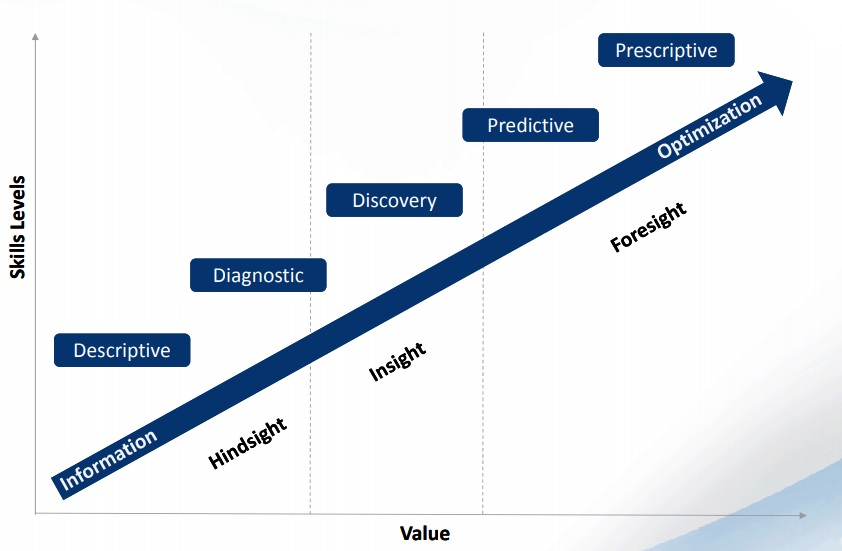About Ace
 Ace Hardware is the world’s largest hardware retail cooperative. Owned by its retailers, spanning more than 5,000 locations and with revenues of more than $5 billion, Ace is a large and complex operation – operating, as most wholesalers do, on narrow margins (about 3 percent net in 2016).
Ace Hardware is the world’s largest hardware retail cooperative. Owned by its retailers, spanning more than 5,000 locations and with revenues of more than $5 billion, Ace is a large and complex operation – operating, as most wholesalers do, on narrow margins (about 3 percent net in 2016).
In an environment where the accurate linkage of incoming inventory with customer product demand is critical to success, Ace has an ongoing need to provide all corporate stakeholders with correct and timely data analysis. The company, which has been using the WebFocus business intelligence suite for 10 years, provides an excellent real-world case study showing how analytics enables a data-driven culture, and how it is likely to evolve in the future.
Defining the journey
Professionals interested in analytics are steeped in the four-step progression – descriptive, diagnostic, predictive and prescriptive – that defines a path leading from hindsight (what happened?) to insight (why did it happen?) and to foresight and data-driven action (what will happen? How can we make it happen?). While some experts tweak the model somewhat – for example, Michael Corcoran of Information Builders has inserted a “discovery” stage between diagnostic and predictive, while other pundits have positioned “cognitive” as an automated stage beyond prescriptive – the overall journey map, credited to Gartner Group, is generally taken as a means of defining the evolution of analytics within an organization.

First steps in the journey
According to Software Engineering Architect Tim Brynda, Ace Hardware’s analytics journey began a decade ago, when the company replaced a tool that it had “outgrown” with WebFocus from Information Builders. It was a move born of frustration, within IT and the user community. Brynda recalled that Ace had “hit the wall” with the previous product: “we ran into all these situations, time after time [saying to business users] “we can’t do that. It doesn’t do that. It doesn’t work that way. No – no – no – no – no. There are only so many times you can tell (users) ‘no’.”
Ace then began the “descriptive” leg of the journey, starting off with a set of standard reports. More recently, Ace has expanded support for diagnostic – which Brynda describes as “still reporting, just more sophisticated” – and discovery activity, through introduction of “guided ad hoc” reporting. Brynda recalled that “in the beginning, we [IT] were developing different tools” for users. Then, he said, “we developed a ‘toolbox’” that Ace employees could use to build their own views of corporate data. The system helped users to access data that can be used to create “millions of potential reports – users pick and choose the measures and dimensions they want…they can drag and drop, click themselves a nice report, they can save it for later if they want to come back and use it as the basis for future reporting, or they can run it on the spot and get that data.” “That freed us up a lot,” he added, “and it freed them up a lot – they weren’t waiting for us, and we weren’t working on quote unquote boring reports.”
Establishing a data-driven culture
Research on analytics adoption, including that carried out by InsightaaS’ Canadian Analytics Business Coalition, often highlights the importance of developing a data-driven culture, and this theme featured prominently in Brynda’s description of Ace Hardware’s use of analytics as well. The challenge is twofold: establishing trust in the data and the way it is used, and building awareness and facility with advanced analytics options.
Resistance is real, even in data-centric businesses

Brynda believes that “at Ace, people are very data savvy and very ‘data heavy’… people want millions of rows” of data. “All of our decisions are based on data. We’re a wholesaler, we’re buying product or selling product, so data goes into almost every decision that is made.”
But despite this reliance on data, Ace users were having trouble embracing advanced reporting. Users of the guided ad hoc systems tended to download large data tables to Excel, eschewing even summary tables. (Brynda observed that “nobody trusts summary data at all. Every time we try to give them a summary table, they say ‘why would I want a summary table? [We say], to make your life a lot easier, to make our lives a lot easier. And they respond, yeah, but what’s in it?”). Generally, the use of analytics tools expands based on experience, but there can be pockets of resistance. In many cases, this is a generational issue, with older employees less likely to embrace analytics than new staff who view data analysis as intrinsic to their business tasks. Meanwhile, some of these younger users enter the organization with preferences for specific tools, and IT can be challenged to keep them focused on outcomes rather than technologies. IT, Brynda explained, needs to stay engaged with these users to “rein in” attempts to introduce rogue analytics tools, to emphasize the cost and data management advantages of using a standard platform, and to work with users to help them “get the most out of” WebFocus.
Into the future: Predictive and Prescriptive
In many places – including Ace Hardware – discussion of future-facing analytics is still more smoke than fire. There is pressure mounting within the business to investigate predictive – “management is hearing about these things at conferences and from peers, and is starting to say ‘we should be doing that’” – but actual implementations are still in their early stages.
Brynda reported that Ace “did one tiny project with Hadoop to get it in the door, so we own it, we’re using it, but we’re very much under-using it.” This initial Hadoop project didn’t really respond to clear business objectives – it is focused on “offloading of stale data…data that people do need every once in a blue moon, but it doesn’t need to be ‘hot data’ in the BI system…Archive is probably too strong of a word…but [the Hadoop system] is not used too often.” Despite this inauspicious beginning, Big Data is “definitely part of ongoing conversations” regarding Ace’s use of predictive analytics.
 According to Brynda, the impetus for these conversations comes from the business units. “We have a couple of math whiz-type people who are looking for advanced capabilities: “business efficiencies, making more money – we’re a wholesaler, we have tens of thousands of products in our warehouses. What should be sitting there, and what should we be buying more of in the next season?” Some of these investigations connect forecasting with what-if analysis – for example, evaluating the Impact of hurricanes on assortment requirements. This type of approach is consistent with what InsightaaS is seeing in its analytics research; as the data needed to populate these queries becomes easier to process (and events like hurricanes become more common), it seems likely that demand for predictive analytics will increase.
According to Brynda, the impetus for these conversations comes from the business units. “We have a couple of math whiz-type people who are looking for advanced capabilities: “business efficiencies, making more money – we’re a wholesaler, we have tens of thousands of products in our warehouses. What should be sitting there, and what should we be buying more of in the next season?” Some of these investigations connect forecasting with what-if analysis – for example, evaluating the Impact of hurricanes on assortment requirements. This type of approach is consistent with what InsightaaS is seeing in its analytics research; as the data needed to populate these queries becomes easier to process (and events like hurricanes become more common), it seems likely that demand for predictive analytics will increase.
In the meantime, though – and at a fundamental level – the value of predictive approaches needs to be proved out, to pave the way to broad use within Ace’s business operations. Brynda said, “the whole idea behind predictive is like a magic eight ball. People put a lot of trust in it. There’s going to have to be a lot of verification behind the models.” This will need to be built over time, and through testing: “at least for us, we’re going to have to build trust. Six months ago, we said this is where we’re going to be, according to the model – where are we in reality, and what needs to be tweaked?’”
Over time, these tests will be conducted, and the models will be refined for use within Ace. How long will this take? “It’s been a long journey” Brynda said, adding that the pace of predictive adoption “might accelerate now,” based on management interest in using the technology to build new business capabilities.
Final words: lessons learned
What has Ace discovered in the course of its analytics journey? When this question was posed to Brynda, he highlighted two key learnings: the need to work with rather than around platform tools, and the requirement for IT to provide leadership in adoption of advanced functionality.
Don’t fight the toolset
Brynda’s first piece of advice was “don’t fight your toolset. Work with the toolset.”
This is a lesson that has painful roots in many corners of the IT experience. Businesses will adopt a platform technology – ERP, CRM, analytics, etc. – and immediately begin making modifications to suit specific user demands. This can work for awhile, but isn’t sustainable; the maintenance overhead builds, and then the system itself breaks when the core platform is due for an upgrade. Ace’s IT department now avoids appeasing individual users’ requests. WebFocus, they say, “can do anything.” IT focuses users on the user’s target results, saying “let us worry about how (the toolset) actually operates.”
Now, with respect to modifications, Brynda said, “we’re into ‘could’ vs. ‘should’” – a discussion that focuses more on the best path forward than the multiple possible side avenues that interest specific users. InsightaaS believes that this is a common reaction to platforms that are the focus of many different user demands. Often, when the first generation of a software platform is introduced, the tool is customized to suit workflows; in the next stage of maturity, workflows are customized to capitalize on the capabilities of the tool.
IT leadership
“If I had asked people what they wanted, they would have said faster horses.”
– attributed to Henry Ford
The famous quote attributed to Henry Ford illustrates how difficult it is for people to see beyond current models into new paradigms. The concept certainly applies to analytics. User expectations are formed by what they know; experience with new approaches often shapes demand for further innovation.
 Brynda has seen this pattern at Ace. “Any single thing we’ve ever rolled out,” he observed, has resulted in requests for additional functionality. As an example, Brynda noted: “We just rolled out a new sales dashboard. We had pulled together a team a year ago to hash out what would be on the new screen.” The group had opted primarily for rows of data, in preference to visualization. But now that the users have had an opportunity to interact with the data visually, “now that it’s been rolled out, people want more visualization…now that they see the finished product, there’s more call for visualization.”
Brynda has seen this pattern at Ace. “Any single thing we’ve ever rolled out,” he observed, has resulted in requests for additional functionality. As an example, Brynda noted: “We just rolled out a new sales dashboard. We had pulled together a team a year ago to hash out what would be on the new screen.” The group had opted primarily for rows of data, in preference to visualization. But now that the users have had an opportunity to interact with the data visually, “now that it’s been rolled out, people want more visualization…now that they see the finished product, there’s more call for visualization.”
Brynda believes that IT’s role evolves with the introduction of advanced technology. IT staff, he said, “were never really big leaders of the organization. We were a service organization…but in this respect, in a BI respect, we do need to lead a little bit. We need to just do it…users will stick to what they’re used to. We need to be more proactive, put it out there… Once they see it, they are very receptive.” Brynda is bullish on the outlook for the next stage of the analytics journey. “We learned our lessons,” he says of the experience that Ace has gained with analytics. “I think we’re in a good position for the future now.”








